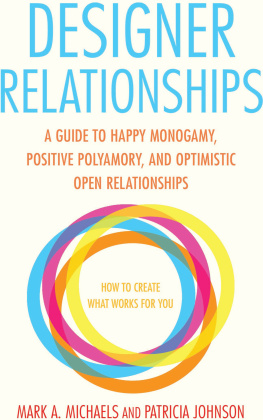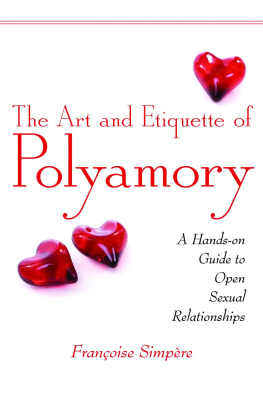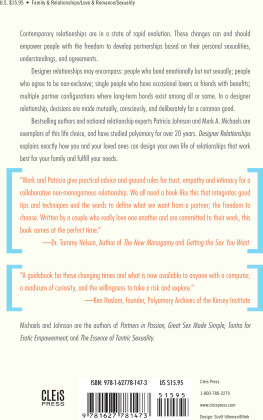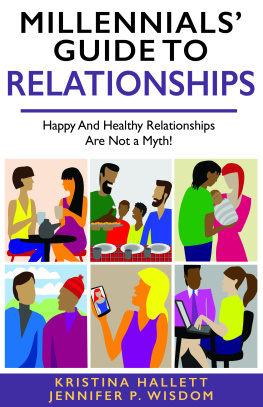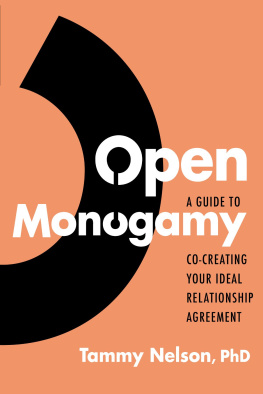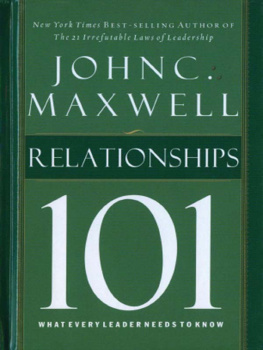

DESIGNER RELATIONSHIPS
DESIGNER RELATIONSHIPS
A GUIDE TO HAPPY MONOGAMY, POSITIVE POLYAMORY, AND OPTIMISTIC OPEN RELATIONSHIPS
MARK A. MICHAELS AND PATRICIA JOHNSON

Copyright 2015 Mark A. Michaels and Patricia Johnson.
All rights reserved. Except for brief passages quoted in newspaper, magazine, radio, television, or online reviews, no part of this book may be reproduced in any form or by any means, electronic or mechanical, including photocopying or recording, or by information storage or retrieval system, without permission in writing from the publisher.
Published in the United States by Cleis Press,
an imprint of Start Midnight, LLC,
101 Hudson Street, Thirty-Seventh Floor, Suite 3705,
Jersey City, New Jersey 07302.
Printed in the United States.
Cover design: Scott Idleman/Blink
Text design: Frank Wiedemann
First Edition.
10 9 8 7 6 5 4 3 2 1
Trade paper ISBN: 978-1-62778-147-3
E-book ISBN: 978-1-62778-149-7
Library of Congress Cataloging-in-Publication Data available on file.
Contents
List of Tips, Techniques, and Tidbits
Foreword
by Kenneth R. Haslam, MD
Founder of the Kenneth R. Haslam, MD Polyamory Archives, the Kinsey Institute, Indiana University
We are living in an era of major change in terms of how we practice sex, love, and relationships. Thanks to the Internet, whole communities now exist that honor a variety of non-monogamous relationship structurespolyamory, swinging, and other alternative arrangements. Finding people and places to explore this wide variety of sexual and romantic options can now be done with ease, something that was hard to imagine a few decades ago. The novel Fifty Shades of Grey has led millions into a consideration of adding kink and BDSM into their intimate repertoire. Marriages have been failing at a high rate for years. Many older people, who find themselves suddenly single, are exposed to a cyber world of online dating and a social acceptance of a new sexuality that are light years away from how they grew up. Many younger people, who may have been raised by divorced parents, are actively seeking healthier alternatives.
Times are changing.
Designer Relationships is a guidebook for these changing times. It explores what is now available to anyone with a computer, a modicum of curiosity, and the willingness to take a risk and explore.
I was born in the mid-1930s and grew up in the very conservative 40s and 50s. My generation was led to believe that our only option was to marry the virginal Prince (or Princess) Charming of the opposite sex, have babies, and live in the suburbs with wood-paneled station wagons. It was assumed that our lifelong partners would meet all our sexual, emotional, and practical needs for sixty years and that we would die in each others arms still ecstatic in love. These misguided beliefs still hold sway in popular culture.
Buying into these myths didnt work for me. After two wives and a couple of long-term girlfriends (I stopped getting married in 1977 after a traumatic divorce), I began to understand that I just wasnt cut out for compulsory monogamy. I was a failed serial monogamist.
In the mid 1990s, my romantic life changed for the better when I bought a modemthe gadget that connected my primitive computer to the then primitive Internet. Quite by accident, I stumbled upon CompuServe and then upon the polyamory community. I had no idea such a thing existed.
It changed my life.
Polyamory introduced me into a new way of thinking about sex, love, and relationships. That old demonmy still abundant raging sex hormones and attendant sex drivecould now be channeled into something that was acceptable to an entire community of intelligent and well-educated people. I could have loving and sexual relationships with more than one person of any gender, in an abundance of relationship structures, and in a myriad of sexual expressions. Honesty and communication were the guiding principles, and everyone knew what was going on. NO CHEATING REQUIRED. Wow! There was a growing and supportive community with local and annual national meetings where I could hang out without stigma.
I became a polyamory activist and flew about the country doing workshops, giving lectures, and talking about my new discovery to everyone who would listen. I established what may be the worlds only formal collection of historical material on polyamory at Indiana Universitys Kinsey Institute of Sex, Gender, and Reproduction. I was hooked, and I was finally at peace with sex, love, and relationships.
A couple of years ago, Mark and Patricia called me for an interview for what would become their very successful book Partners in Passion. They were well informed, agenda-free, and sex positive; they took plenty of time, so the interview was comfortable, extensive, and penetrating. We discussed the wide variety of names given to the myriad forms of relationship and sexual expressions available. We also discussed what I call the swing/poly-wars, during which activists argued over the differences between swinging and polyamory, as well as the heated and failed debates over defining polyamory in a way that would satisfy everyone. During those wars, I started using the term designer relationships as an alternative. Designer Relationships demanded only that all parties sit down and discuss openly what each one wanted and how the relationships would progress as life and times changed. Discussion of relationship fluidity (and even sexual fluidity) was mandatory because children, new partners, shifts in sexual orientation, and just plain getting old can all come into play. For me, this was the perfect term for this new age.
For many years, I planned on writing a book with the title Designer Relationships, but a major geographical move, a new romantic partner, increasing age, impending senility, procrastination, and just plain laziness got in the way. My conversations with Mark and Patricia, however, were fruitful, and we all eventually understood that they would write the book.
My vision was always that this would be a short book that could be purchased in an airline terminal in Boston and be finished before landing in Los Angeles. Designer Relationships meets that criterion (well, almost for slow readers). Patricia and Mark have done an admirable job covering the wide variety of subjects so necessary for understanding the vast, ill-defined and ever changing world of consensual non-monogamy.
Thank you, Mark and Patricia, for doing what I was too lazy to do!
Introduction
OURS HAS BEEN A designer relationship from the very start, though we were not familiar with the term at the time. When we got together in 1999, it was to practice sexual Tantra. Neither one of us was seeking a long-term partner, but things evolved quickly, to our surprise. Once it became clear that this was more than a casual or purely practical relationship, we began what has been an ongoing process of examining and purposefully shaping our partnership.
Time passed. The relationship deepened, and so did our trust in each other. With that trust came the ability to be more adventurous, and in the intervening years weve been exposed to a wide variety of alternative sexual and relationship communities and have presented to a broad spectrum of peoplefrom monogamous to pansexualand weve done our share of sexual exploration, while maintaining a strong pair-bond.
Next page
